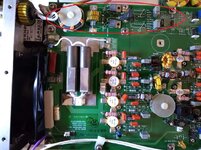alphamike
Newbie
I am trying to understand how RF power generators are designed so that I can try to fix a problem with my Seren 600W RF generator (13.56MHz). I could not find much information on what is inside these generators. Looking at the circuit board, it appears to be an oscillator circuit followed by a power amplifier and some filters. What I don't know is how the output power and reflected power are being measured.
This RF generator is having intermittent problems. The forward power suddenly drops from the set value (lets say 100W) to something very small, like 5W. After a reset, it seems to work fine for a little while, and then the problem begins again. I am trying to understand where the problem might be.
This RF generator is having intermittent problems. The forward power suddenly drops from the set value (lets say 100W) to something very small, like 5W. After a reset, it seems to work fine for a little while, and then the problem begins again. I am trying to understand where the problem might be.
